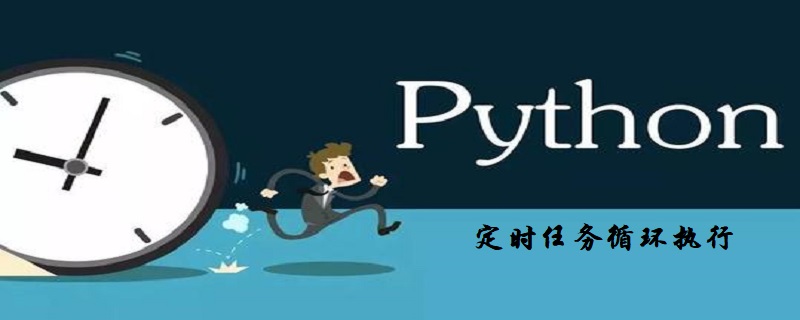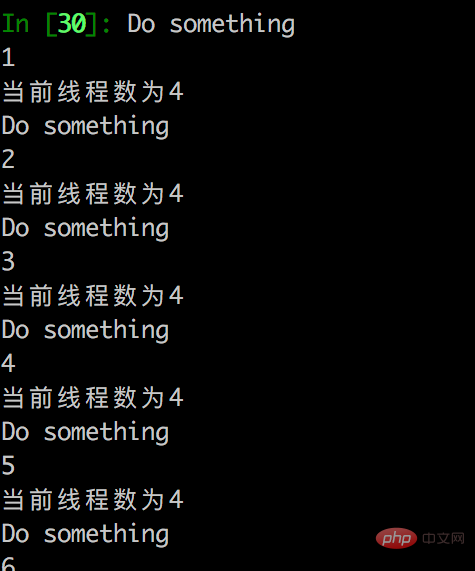在我们的实际开发中,经常有这样的一种需求:要求某个功能模块或任务在相同的时间周期内进行循环执行。这里有了一个定时器的概念,具体而言我们应该如何去实现一个定时器呢?定时器有许多很实用的功能,能够控制线程的执行、减少系统的消耗等。现在我们来动手实践实现Python3中的定时功能吧。

比如使用Python在进行爬虫系统开发时可能就需要间隔一段时间就重复执行的任务的需求,从而实现一个线程服务在后台监控数据的抓取状态,这里定时器就可以帮忙了。
【视频推荐:Python3视频教程】
【手册推荐:Python中文手册】
通过Python的文档我们可以找到threading.Timer()来实现定时功能:
简单实现代码:
import threading
def func1(a):
#Do something
print('Do something')
a+=1
print(a)
print('当前线程数为{}'.format(threading.activeCount()))
if a>5:
return
t=threading.Timer(5,func1,(a,))
t.start()效果图:

通过查阅资料,利用Python能实现三种不同的定时任务执行方式:
1.定时任务代码
#!/user/bin/env python #定时执行任务命令 import time,os,sched schedule = sched.scheduler(time.time,time.sleep) def perform_command(cmd,inc): os.system(cmd) print('task') def timming_exe(cmd,inc=60): schedule.enter(inc,0,perform_command,(cmd,inc)) schedule.run() print('show time after 2 seconds:') timming_exe('echo %time%',2)
2.周期性执行任务
#!/user/bin/env python import time,os,sched schedule = sched.scheduler(time.time,time.sleep) def perform_command(cmd,inc): #在inc秒后再次运行自己,即周期运行 schedule.enter(inc, 0, perform_command, (cmd, inc)) os.system(cmd) def timming_exe(cmd,inc=60): schedule.enter(inc,0,perform_command,(cmd,inc)) schedule.run()#持续运行,直到计划时间队列变成空为止 print('show time after 2 seconds:') timming_exe('echo %time%',2)
3.循环执行命令
#!/user/bin/env python
import time,os
def re_exe(cmd,inc = 60):
while True:
os.system(cmd)
time.sleep(inc)
re_exe("echo %time%",5)总结而言:Python实现定时器的方法都是schedule和threading的实现,具体的用法还要根据实际情况灵活运用。
最常用的两个模块:threading、Sched
threading模块使用:
import threading ,time
from time import sleep, ctime
class Timer(threading.Thread):
"""
very simple but useless timer.
"""
def __init__(self, seconds):
self.runTime = seconds
threading.Thread.__init__(self)
def run(self):
time.sleep(self.runTime)
print ("Buzzzz!! Time's up!")
class CountDownTimer(Timer):
"""
a timer that can counts down the seconds.
"""
def run(self):
counter = self.runTime
for sec in range(self.runTime):
print (counter)
time.sleep(1.0)
counter -= 1
print ("Done")
class CountDownExec(CountDownTimer):
"""
a timer that execute an action at the end of the timer run.
"""
def __init__(self, seconds, action, args=[]):
self.args = args
self.action = action
CountDownTimer.__init__(self, seconds)
def run(self):
CountDownTimer.run(self)
self.action(self.args)
def myAction(args=[]):
print ("Performing my action with args:")
print (args)
if __name__ == "__main__":
t = CountDownExec(3, myAction, ["hello", "world"])
t.start()
print("2333")Sched模块使用:
'''
使用sched模块实现的timer,sched模块不是循环的,一次调度被执行后就Over了,如果想再执行,
可以使用while循环的方式不停的调用该方法
'''
import time, sched
#被调度触发的函数
def event_func(msg):
print("Current Time:", time.strftime("%y-%m-%d %H:%M:%S"), 'msg:', msg)
def run_function():
#初始化sched模块的scheduler类
s = sched.scheduler(time.time, time.sleep)
#设置一个调度,因为time.sleep()的时间是一秒,所以timer的间隔时间就是sleep的时间,加上enter的第一个参数
s.enter(0, 2, event_func, ("Timer event.",))
s.run()
def timer1():
while True:
#sched模块不是循环的,一次调度被执行后就Over了,如果想再执行,可以使用while循环的方式不停的调用该方法
time.sleep(1)
run_function()
if __name__ == "__main__":
timer1()以上是通过Python3实现任务的定时循环执行的详细内容。更多信息请关注PHP中文网其他相关文章!
 什么是Python Switch语句?Apr 30, 2025 pm 02:08 PM
什么是Python Switch语句?Apr 30, 2025 pm 02:08 PM本文讨论了Python版本3.10中介绍的新“匹配”语句,该语句与其他语言相同。它增强了代码的可读性,并为传统的if-elif-el提供了性能优势
 Python中的功能注释是什么?Apr 30, 2025 pm 02:06 PM
Python中的功能注释是什么?Apr 30, 2025 pm 02:06 PMPython中的功能注释将元数据添加到函数中,以进行类型检查,文档和IDE支持。它们增强了代码的可读性,维护,并且在API开发,数据科学和图书馆创建中至关重要。
 Python的单位测试是什么?Apr 30, 2025 pm 02:05 PM
Python的单位测试是什么?Apr 30, 2025 pm 02:05 PM本文讨论了Python中的单位测试,其好处以及如何有效编写它们。它突出显示了诸如UNITSEST和PYTEST等工具进行测试。
 Python中的__Init __()是什么?自我如何在其中发挥作用?Apr 30, 2025 pm 02:02 PM
Python中的__Init __()是什么?自我如何在其中发挥作用?Apr 30, 2025 pm 02:02 PM文章讨论了Python的\ _ \ _ Init \ _ \ _()方法和Self在初始化对象属性中的作用。还涵盖了其他类方法和继承对\ _ \ _ Init \ _ \ _()的影响。
 python中的@classmethod,@staticmethod和实例方法有什么区别?Apr 30, 2025 pm 02:01 PM
python中的@classmethod,@staticmethod和实例方法有什么区别?Apr 30, 2025 pm 02:01 PM本文讨论了python中@classmethod,@staticmethod和实例方法之间的差异,详细介绍了它们的属性,用例和好处。它说明了如何根据所需功能选择正确的方法类型和DA
 您如何将元素附加到Python数组?Apr 30, 2025 am 12:19 AM
您如何将元素附加到Python数组?Apr 30, 2025 am 12:19 AMInpython,YouAppendElementStoAlistusingTheAppend()方法。1)useappend()forsingleelements:my_list.append(4).2)useextend()orextend()或= formultiplelements:my_list.extend.extend(emote_list)ormy_list = [4,5,6] .3)useInsert()forspefificpositions:my_list.insert(1,5).beaware


热AI工具

Undresser.AI Undress
人工智能驱动的应用程序,用于创建逼真的裸体照片

AI Clothes Remover
用于从照片中去除衣服的在线人工智能工具。

Undress AI Tool
免费脱衣服图片

Clothoff.io
AI脱衣机

Video Face Swap
使用我们完全免费的人工智能换脸工具轻松在任何视频中换脸!

热门文章

热工具

螳螂BT
Mantis是一个易于部署的基于Web的缺陷跟踪工具,用于帮助产品缺陷跟踪。它需要PHP、MySQL和一个Web服务器。请查看我们的演示和托管服务。

EditPlus 中文破解版
体积小,语法高亮,不支持代码提示功能

SublimeText3 英文版
推荐:为Win版本,支持代码提示!

SublimeText3 Linux新版
SublimeText3 Linux最新版

记事本++7.3.1
好用且免费的代码编辑器







